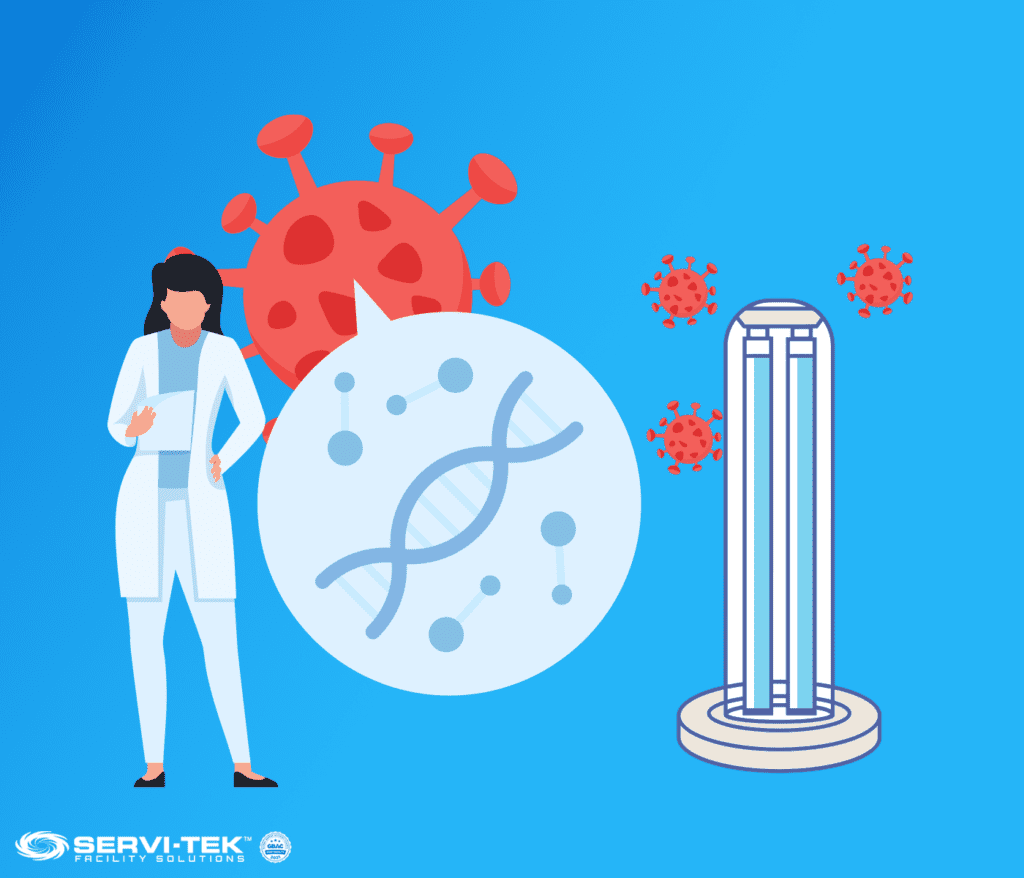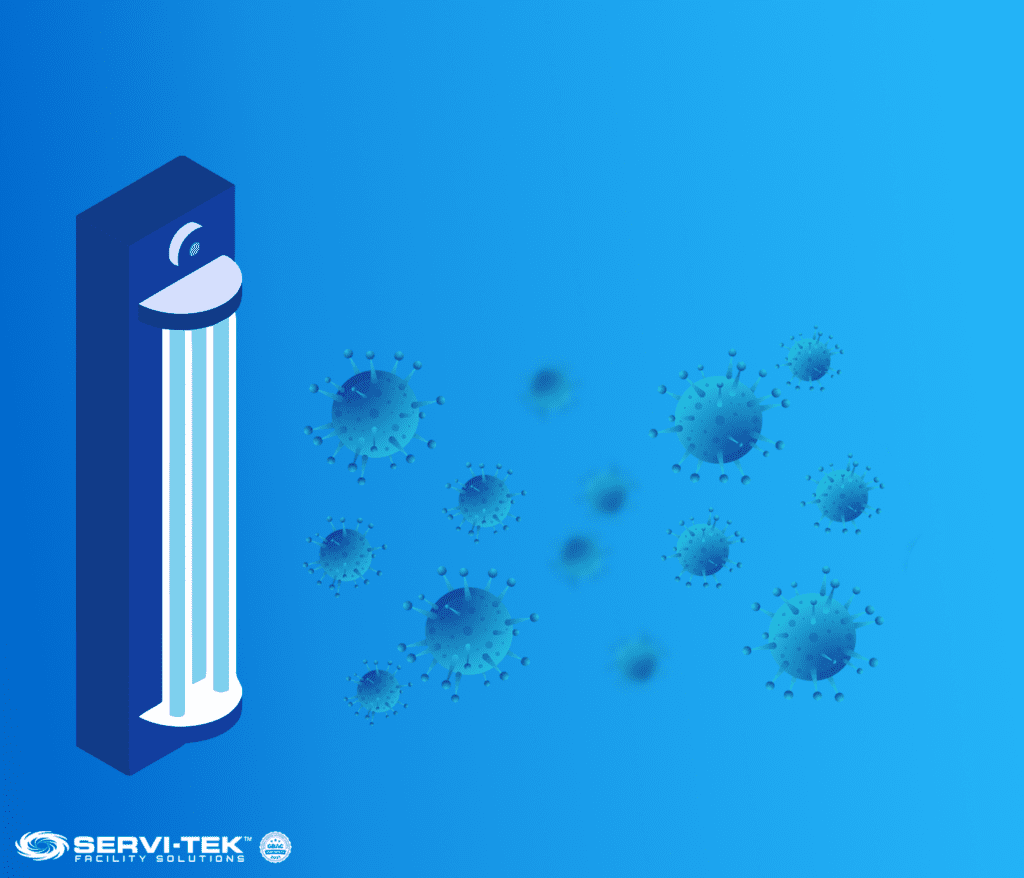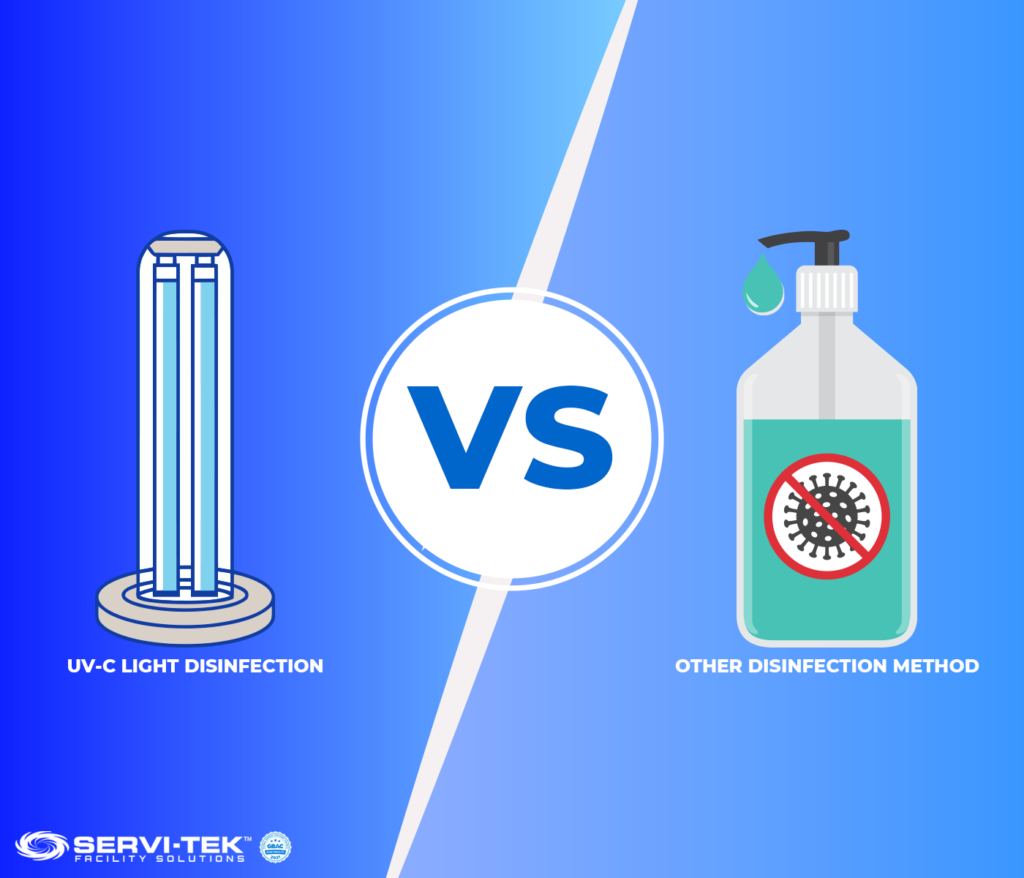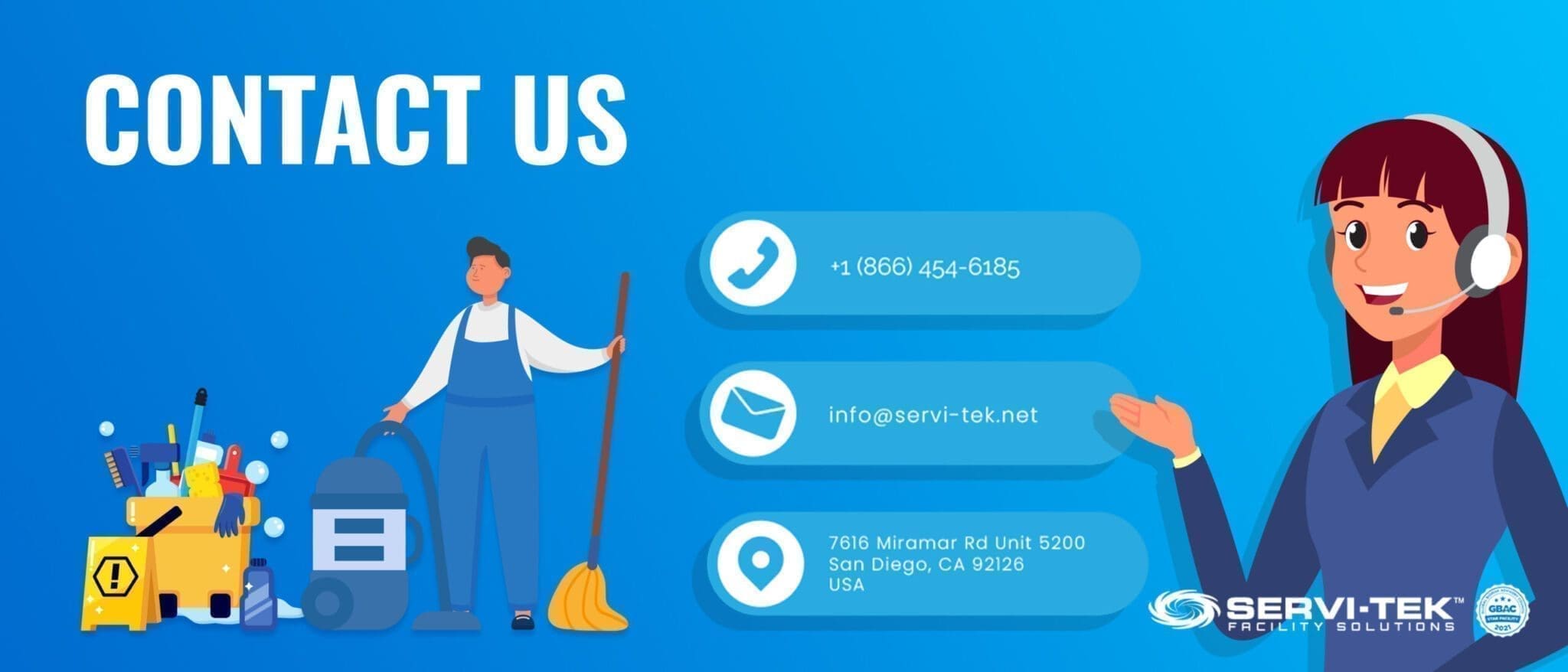We need clean air, water, and surfaces for our health and well-being.
Many of us spend a significant portion of our lives at work, and we come into contact with a variety of unsanitary objects. From keyboards to coffee mugs, and from air filters to food, germs thrive if left untreated.
They’re all excellent UV-C disinfection candidates.
But what exactly is UV-C light and how can it help your business?
UV-C Light

If this is the first time you’ve heard about HV-C light disinfection, you’re not the only one.
In fact, many people haven’t heard of it, although it has been around for quite a while.
Since the 1930’s to be more exact – that is when UV-C started to gain popularity in hospitals and was used for disinfection.
In short, UV-C radiation acts as a disinfectant for air, water, and surfaces.
Now, in the midst of an ongoing coronavirus pandemic, its benefits are starting to expand beyond the medical world, as more businesses started to hear about it and its efficiency.
In terms of the HVAC industry, it is actually a defining technology and trend for 2021 and the years to come.
How Does It Work?

There are three types of ultraviolet light: UV-A, UV-B, and UV-C.
UV-C, like the other two, is mainly derived from the sun.
One important thing to know is that it does not reach us because it is absorbed by our atmosphere.
Sanitizing systems use UV-C lights to clean surfaces. The light produced by these devices is powerful enough to destroy bacteria and the virus’s genetic material.
How does HV-C light destroy microbes?
Bacterias depend on their DNA to survive since they are only one cell.
UV light air purifiers work on this principle.
When the DNA of a bacterial cell is sufficiently weakened, it activates a self-destruct mechanism that renders the cell harmless.
What It Is
UV-C is a form of ultraviolet radiation, UV for short.
Ultraviolet is actually a form of electromagnetic radiation, not light.
UV is outside of our visible light spectrum. We can feel the impact of UV radiation even though we can’t see it.
All UV lights contain a significant amount of energy.
However, how does this energy translate into successful commercial cleaning?
Molecules are broken down by high-energy radiation.
This radiation kills living cells, such as bacteria, viruses, and other living organisms, therefore disinfecting the surfaces it comes into contact with.
The closest you can come to see the effects of UV radiation in your daily life is getting sunburned if you don’t use sunscreen.
Although the Earth’s ozone layer prevents the majority of higher-energy radiation from reaching our skin and causing serious harm, some UV radiation does get through, causing burns and other skin issues.
Will It Impact My Office Environment Negatively?
UV-C, also known as germicidal light, has several environmental and economic benefits, but also some drawbacks.
Continue reading to find out if it’s a safe solution for your office and commercial properties.
Many of the amenities, such as kitchens, desks, meeting rooms, toilets, and so on, are shared by the tenants and office workers.
While viruses like COVID-19 usually reach from person to person by coughing, sneezing, or speaking, they can live on surfaces for a long time and spread when we touch an infected region.
Several touchpoints in the workplace can be a source of contamination.
UVC light can be used to effectively disinfect the air, water, and food, making it a very flexible solution.
However, when UV-C lights are not regulated, they can be harmful.
For that reason, you might ask yourself “Is UV-C light dangerous for my offices and tenants?“
This is a very important question to ask and understand.
Direct exposure to germicidal ultraviolet lighting, if not used or applied correctly, can be harmful to both materials and individuals.
Humans can be affected by UV-C lighting in several ways, including eye and skin damage.
One of the simplest ways to prevent the negative effects is to ensure that every UV-C light device under consideration has a reverse occupancy sensor.
This means that the system will not work if a person enters a space while it is disinfecting.
But this is not the only option.
The market is very diverse when it comes to the type of UV-C systems you can use.
There are UV-C lights that do not pose the risk of coming in direct contact with people: robots, the lights in HVAC systems, or those manually used by experts.
Some systems can be used in a room at the same time people are there.
These devices are mounted high in the room and use natural convection to clean the air as it moves through a well-controlled and narrow UV-C irradiated zone that stays close to the ceiling.
This zone is located at a higher elevation than where people normally congregate. The devices are at least 2.3 meters above the ground and are shielded so that no one below them is exposed to the radiation.
You should know that UV lighting is an FDA-approved industry.
The Center for Disease Control (CDC) also recommends UV-C disinfection as one of the best defenses for safely disinfecting face masks.
Disinfection Process
Germs in water, the air, and on surfaces are a constant source of concern.
As we learned before, microorganisms are easily and rapidly killed through intense UV light.
It also improves hygiene and storage conditions.
The germ-contaminated air can be directly disinfected in the supply air ducts to reduce the number of risk factors in the long run.
To use UV lighting properly in public settings, you’ll need specialized equipment and training.
In most cases, purchasing specialized equipment would provide the necessary knowledge and skills.
While some residential UV lighting applications do not necessitate training, any large-scale commercial application would necessitate instruction to ensure proper and safe use.
How can I get started?
We recommend using the services of a professional cleaning company, that has the expertise in this field.
It is best to opt for a firm with diversified services, as you’ll have a long-term, secure partner, and your costs will be reduced.
For example, when the technicians perform regular HVAC maintenance, they can also check the UV-C lights and their performance.
You’ll save time, money and benefit from the top, safe services.
Should I Use A UV-C Light In The Office?
If you are not sure whether to take this step or not, take a look over the benefits of using UV-C light in the office, compared to other disinfection methods:
- Chemicals and toxic compounds are not needed for UV-C radiation
- UV-C radiation does not enable pathogens to develop resistance over time
- In a matter of seconds, the radiation makes pathogens harmless
- The limited length of the procedure does not affect the product’s properties
- On surfaces, UV-C radiation leaves no trace or discoloration
For these purposes, UV-C radiation has been used as a cleaning method in certain industries for decades, such as medicine and food packaging disinfection – even in yogurt pots.
What Are Radon Tests?
Radon is a toxic gas that occurs naturally and can cause lung cancer. Radon gas is odorless, colorless, and inert. It is a naturally occurring element in the atmosphere.
Excessive amounts of radon gas can be found in almost every form of the workplace, regardless of its size or design. The amount of radon that collects in a structure is determined by its position, structure, and use.
Breathing radon for an extended period of time increases the risk of lung cancer. In the United States, radon is the second leading cause of lung cancer.
Radon tests can detect radon gas or its daughter products, which are the byproducts of radon’s radioactive decay.
The amount of gas inside a building is determined by the amount of ventilation and the nature of the work.
You cannot escape from it directly as you cannot change the location of your building, but there are solutions to it.
The best one is your own HVAC system.
It filters the air inside and eliminates all gases and dangerous compounds.
But HVAC systems also have their own limits, if not properly maintained. The filters and systems gather dust and toxic particles in time, and can even develop mold.
When such cases occur, a UVC lamp installed can make wonders, as it keeps the interior clean and disinfected at all times.
It rarely needs maintenance, as the UV lamp can last for more than a year.
Also, thanks to your safe and efficient HVAC system, windows don’t need to stay open constantly, and the pollutants from outside stay outside and bring no negative effects on your tenants.
How Does UV-C Light Disinfect The Air?

UV-C light is known for efficient air disinfection in a rather straightforward manner.
As previously mentioned, the UV-C lamps that have the ability to modify the DNA of microorganisms, rendering them inactive or dead. The same happens in the air. The UV-C light reaches particles and microbes waiting for their new host, and almost instantly kills them.
Air quality is increasing in importance for tenants across the US, and not only.
Did you know that 58% of property managers have experienced an increase in requests from tenants for more frequent changing or cleaning of air filters?
The number does speak for itself.
UV-C Lights And Their Potential Uses
UV-C lamps are used to disinfect mold, bacteria, and other viruses in industrial facilities using UVC light disinfection.
In grocery stores, commercial office buildings, and other public gathering places, germicidal lamps are used to sterilize workspaces and equipment.
UVC Light disinfection is the ideal method for disinfecting the many surfaces, water, and air quality in your commercial property.
Where Does The UV-C Light Come From?
Radiation is a form of energy that is often invisible to the naked eye.
Sunlight is the most common source of UV radiation, which emits three types of UV rays: UVA, UVB, and UVC.
UVA light is the light with the least amount of energy. You’re mostly exposed to UVA light when you’re out in the sun. Skin aging and damage have been related to UVA light exposure.
UVB light is located in the center of the UV spectrum. It is present in a limited amount of sunlight.
It’s the most common form of UV light that causes sunburns and most skin cancers.
UVC light has the greatest amount of energy. The sun’s UVC radiation is mainly absorbed by the Earth’s ozone, so you’re not exposed to it regularly.
There are, however, a variety of human-made UVC light sources.
Although UVA and UVB rays pass through the atmosphere, the Earth’s surface and ozone layer absorb all UVC and some UVB rays.
As a result, the majority of UV rays you encounter are UVA, with a tiny amount of UVB.
As scientists began to realize the benefits of UV-C light, they started to produce lamps and systems made with special fused quartz glass.
How Does UV-C Light Work To Kill Bacteria?
The genetic material that makes up all living organisms and controls their growth, development, functioning, and reproduction is constituted of nucleic acids, forming DNA and RNA.
UV light emits electromagnetic energy, which can destroy microorganisms’ ability to reproduce, and inactivates them by causing mutations or cell death.
UV-C Light: A Review Of Its Benefits
Here’s all you need to know, in details, about the benefits you can have from a UV-C system:
Extremely effective
Disinfecting with UV-C lights can be much more efficient than other methods. UV light destroys a wide range of bacteria and viruses.
Molds and spores are destroyed when other disinfection methods might not be as efficient, or they can leave a damp atmosphere just perfect for the growth of fungi.
No toxins
One of the most important benefits of UV-C light disinfection is that it’s non-toxic.
UV-C light is environmentally friendly, unlike the harsh chemicals that are often used in cleaning and sanitization items.
Light disinfection is a physical, not a chemical, operation.
Although excessive UV exposure can damage humans, proper protection makes this a safe and non-toxic disinfection process.
Affordable
UV disinfection is a cost-effective sanitization technique. People mistakenly believe it is more expensive because it employs technology rather than chemicals, but this is not the case.
There are no maintenance costs over the life of the device, and because the unit can run automatically, a one-time investment in UV light disinfection will save you time and money for years.
Safe to use
Is UV-C light disinfection safe to use?
People often associate UV-C exposure with risks such as sunburn, but the important thing to remember is that when used properly, UV light is completely safe.
If you take the proper care, UV-C light is less likely to cause harm than the harsh chemicals in common cleaning materials.
Microbes cannot develop resistance to this technology
You must’ve often read news about antibiotic-resistant bacteria.
In the medical world, the emergence of antibiotic-resistant bacteria is a major issue.
UV light disinfection, unlike conventional disinfection methods, is a physical way of killing bacteria.
As a result, microbes and viruses such as the Sars-Cov-2 virus are unable to develop resistance to it.
This is a significant benefit, particularly for hospitals, medical devices, and assisted living facilities.
Improved airflow and HVAC system
In time, mold and fungi grow on your HVAC coils and surrounding areas, decreasing airflow and putting the unit’s efficiency at risk.
UV lights mounted in an HVAC unit’s duct system provide a highly effective layer of protection against several harmful airborne microorganisms.
Since it does not have to work as hard to transfer air through the coils, an HVAC device supplemented with UV-C can last longer and need less maintenance.
The Infection Control Advantage
The global COVID-19 pandemic caused by coronaviruses has put conventional surface disinfectants to the test.
It has also prompted companies and organizations to develop and invest in ultraviolet-disinfection systems.
Why are the UV-C systems becoming more and more popular?
UV-C disinfection is scientifically tested, easy to use, and does no harm to the fabric of the treated area or buildings.
This approach is chemical-free, reaches every inch from floor to ceiling, and can be used in even the tiniest of spaces.
Depending on what you buy, it can be very easily transportable, which means it can be used in cramped places and moved from a room to another.
This makes infection control a reachable and affordable target.
The UV-C Disinfection Light Is A Compelling Business Choice
UV sterilization, also known as ultraviolet germicidal irradiation, is very efficient, as we’ve seen.
UV sterilization sources will destroy over 99 percent of viruses, bacteria, and fungi in a matter of seconds.
Because of its efficacy, numerous UV treatments and specialized UV sterilization devices have been developed.
Both commercial property owners and maintenance firms should consider in-duct HVAC systems, cooling coil units, air movers, and upper room air purifiers to achieve this.
Businesses that have implemented ultraviolet germicidal irradiation systems will likely be able to remain open in the future and generate confidence with the general public.
It is a safe, affordable, environmentally friendly, and efficient solution for top commercial spaces.
It ensures proper prevention and eliminates any risk almost immediately.
Advantages Of UV-C Light Disinfection
In times when conventional surface disinfectants are in short supply, UV-C can be a valuable alternative to solution-based products due to its well-documented antimicrobial activity.
Since effectiveness is highly dependent on individuals and their motivation, manual cleaning and disinfection are variable, and measuring this requires direct on-site observation.
Manual cleaning in each commercial facility is focused on local procedures, preparation, awareness, and staff turnover of cleaning staff, as well as the monitoring and inspection of their results, despite best practice guidelines.
Compare the above to UV-C light disinfection, which requires minimal human intervention while providing superior results.
Where UV-C Light Disinfection Can Be Used
UV lights can be used as part of mobile machines that disinfect surfaces, whether they are robotic or human-controlled.
They can also be used to clean indoor air by incorporating them into heating, ventilating, and air-conditioning systems, or by strategically placing them within airflows.
For years, hospitals have used UV-C light-emitting robots to clean patient rooms, operating rooms, and other places where bacteria can spread.
UVC can be used for buses, trains, and plane disinfection.
Businesses are now looking at using the technology to clean warehouses and retail locations.
Similarly, UV light sources can be used in HVAC systems to clean air as it flows through ductwork. UV technology could also be used to clean the air in an aircraft or to disinfect bathrooms between uses.
Comparison To Other Disinfection Methods

Below you can find a comprehensive comparison between UV-C light disinfection and other, more classic cleaning methods.
Human error
While most disinfectants are 99.99% effective against germs, cleaning crews may reduce their effectiveness.
Why?
Because, first and foremost, a thorough cleaning is needed.
Second, pathogens can not be killed if the surface isn’t wet long enough. A recommended period of time for the disinfectant to be on the surface to destroy germs should be followed, otherwise, the colonies might not be fully destroyed.
Third, cleaning crews can simply overlook or forget surfaces as they are cleaning through a room.
Line of sight
The line of sight rule is one of the most significant obstacles for UV-C products.
Shadows and items in a room affect the light and UV rays emitted. You will need to run several cycles with the correct dose to achieve complete disinfection.
UV products also have a limited ability to penetrate dust and other particles on a surface.
Side effects
Both disinfectant and UV-C products have potentially adverse side effects for humans.
The difference is that UV-V does not leave chemical trails and is not toxic to the environment.
Following manufacturer instructions and current safety procedures should be the standard operating procedures for both.
Disadvantages Of UV-C Light Disinfection
It’s crucial to have the germicidal UV products installed correctly, to avoid negative side effects.
When UV-C light is applied for a long period of time to living tissues, it can cause cancer.
Exposure to the eyes is equally dangerous.
UV-C rays can only be used in empty spaces, according to the manufacturers.
Wear suitable protective equipment, such as gloves, goggles, and long sleeves, when performing repairs or operating items.
Get started
Servi-Tek can help you keep your office clean and safe by providing a range of cleaning and disinfecting services.
For workplaces, we provide high-impact disinfecting services with increased frequency and convenient timing.
Our high-level disinfecting services range from electrostatic spraying to UV light disinfection.
We have been in the industry for an extended period of time, and our expertise is at the base of our services.
If you are looking for affordable, efficient, and professional services, give us a call today at (866) 454-6185 or use our online contact form.




